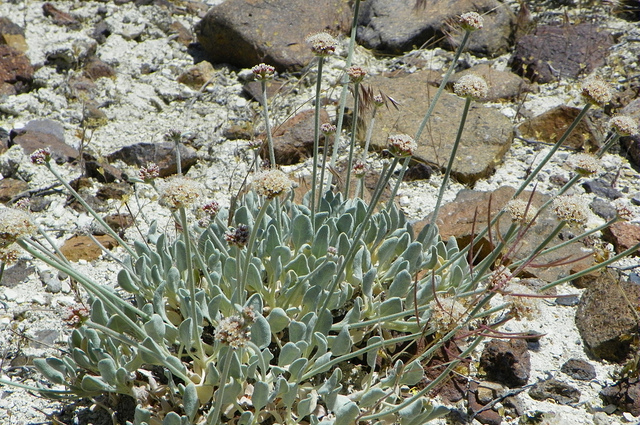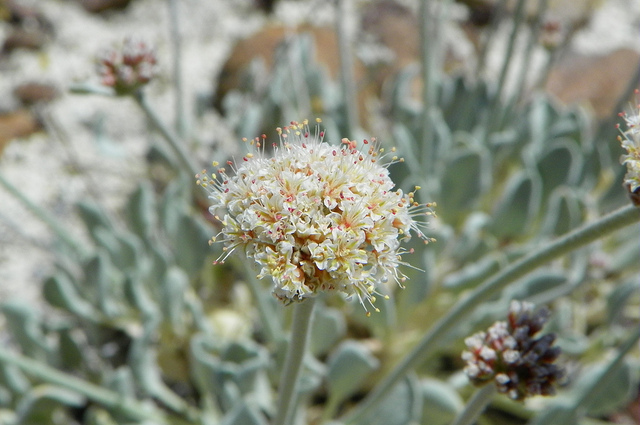Here is a rare Eriogonum.
Eriogonum diatomaceum is considered critically endangered by the state of Nevada and has been put forward as a candidate for federal protection. Therefore seed is not currently available. (sorry :-[)
Not as showy as some but still nice enough. This one has a very long blooming season of well over two months. Starting in early June and going into mid August.
The slopes this grows on, are stark white diatomaceous deposits cobbled with dark volcanic rock.
http://www.plantsystematics.org/reveal/pbio/RevealSlides/polgeridia.html
http://www.efloras.org/florataxon.aspx?flora_id=1&taxon_id=250060256
Interestingly one of the common pollinators is the Western Pygmy Blue Butterfly. The smallest butterfly in North America. The scientific name is Brephidium exilis (Lycaenidae). It has a wingspan of only 5 to 7 mm. It uses Four-Wing Saltbush (Atriplex canescens), as one of it's host plants. This happens to be one of the common desert shrubs that inhabit the arroyos in this area.
http://bugguide.net/node/view/25198/bgimage
Here are shots of Eriogonum diatomaceum in habitat.




Comments
Mark McDonough
Re: Eriogonum diatomaceum
Tue, 12/07/2010 - 7:24pmCool, but endangered species. I like learning about the tiny pollinator, the Western Pygmy Blue Butterfly... thanks for providing the links.
Trond Hoy
Re: Eriogonum diatomaceum
Wed, 12/08/2010 - 3:50amI had to look up the tiniest Norwegian bluewing - and it is way bigger! (18-25mm)!
Even this rare Erigeron is beautiful although not very colorful!
John P. Weiser
Re: Eriogonum diatomaceum
Wed, 12/08/2010 - 6:17amMark and Hoy
I debated about posting this one because it's so rare that it probably will never be in gardens. Then I decided that it was worth posting just to show the harsh of habitat this species has adapted to. Besides it gave me the excuse to show the cute little pygmy butterfly. ;D
HughGmail (not verified)
Re: Eriogonum diatomaceum
Thu, 12/09/2010 - 7:45amJohn does not exaggerate when he speaks of the harsh habitat - this was one of the sites the Eriogonum Society visited in June 2010. This, along with the site for Eriogonum ovalifolium var. williamsiae were both very remarkable in their starkness. As I travel the west I am always amazed at the adaptability of the genus. There is a location in Wyoming on the Laramie plains where Eriogonum acaule poke out of a dirt parking area near a small recreational lake like ancient Brillo Pads. Of course my group reveres the little guys, taking care not to insult them with the weight of motorized vehicles, but I cannot testify that the locals have any idea what treasures these are.
Trond Hoy
Re: Eriogonum diatomaceum
Sat, 12/11/2010 - 8:34amEven if a plant is rare it is worth posting pictures of it. I would, of course, like to see it in situ but the next best is pictures! I realize it is many plants I never shall have the pleasure to beheld in their native habitat!
John P. Weiser
Re: Eriogonum diatomaceum
Sat, 12/11/2010 - 10:39amThat all depends on if you are ever able to come out to Reno, some day. I know someone who knows were it grows. ;D
Trond Hoy
Re: Eriogonum diatomaceum
Sat, 12/11/2010 - 11:01amSeems I have a reason to take a vaccation in USA once more!